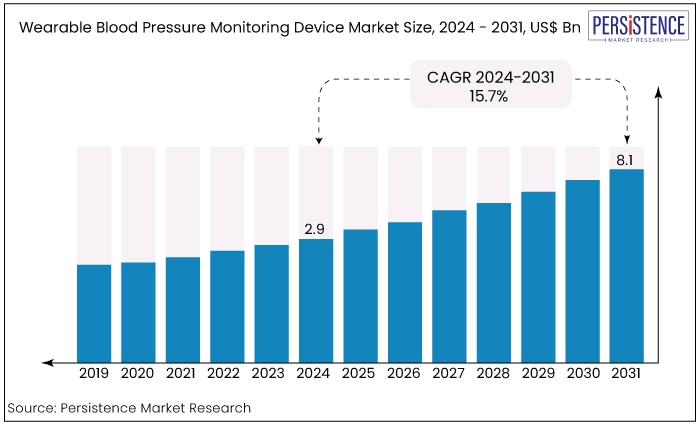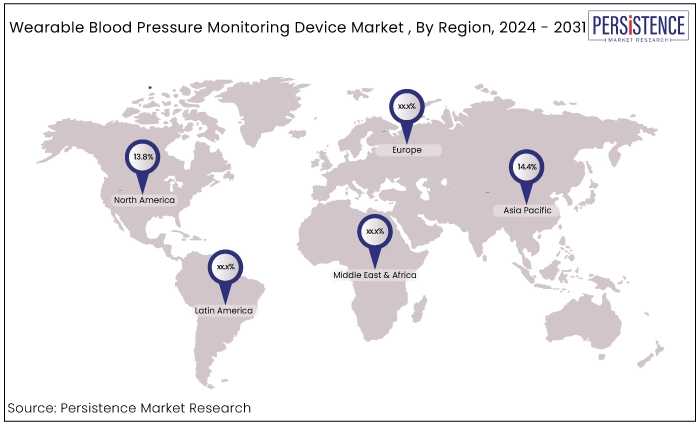Industry: Healthcare
Published Date: August-2024
Format: PPT*, PDF, EXCEL
Delivery Timelines: Contact Sales
Number of Pages: 198
Report ID: PMRREP34562
Wearable blood pressure monitoring device market is estimated to value at US$8.1 Bn by the end of 2031 from US$2.9 Bn estimated in 2024. The market is expected to secure a CAGR of 15.7% in the forthcoming years from 2024 to 2031.
Key Highlights of the Market
|
Market Attributes |
Key Insights |
|
Wearable Blood Pressure Monitoring Device Market Size (2024E) |
US$2.9 Bn |
|
Projected Market Value (2031F) |
US$8.1 Bn |
|
Forecast Growth Rate (CAGR 2024 to 2031) |
15.7% |
|
Historical Growth Rate (CAGR 2018 to 2023) |
14.0% |

The wearable blood pressure monitoring device market is a rapidly growing segment of the healthcare technology industry. The market is driven by the increasing prevalence of hypertension and the need for continuous monitoring of blood pressure.
Wearable devices offer a non-invasive and convenient way to track blood pressure, providing users with real-time information to manage their health. With advancements in technology, these devices are becoming increasingly accurate, user-friendly, and affordable.
The market for wearable blood pressure monitoring devices is also driven by the growing demand for portable and wireless health monitoring solutions, which enable users to track their blood pressure remotely. As a result, the market is expected to experience significant growth in the coming years.
The integration of Artificial Intelligence (AI), and machine learning (ML) into wearable blood pressure monitoring devices represents a significant innovation in the market.
These technologies enhance the ability of devices to analyse large volumes of data with greater accuracy and speed. AI algorithms can detect patterns and trends in blood pressure readings, providing insights that might be missed by traditional analysis methods.
Machine learning models can predict potential health issues, enabling proactive management of conditions like hypertension. These intelligent systems can personalize health recommendations based on individual user data, offering tailored advice for lifestyle modifications and medication adjustments.
The continuous learning capability of AI and ML ensures that the devices improve over time, adapting to the user’s unique health profile. This integration not only boosts the accuracy and functionality of wearable monitors but also empowers users and healthcare providers with actionable insights, ultimately enhancing patient outcomes and advancing preventive healthcare.
The wearable blood pressure monitoring device market has witnessed substantial growth, driven by increasing health awareness and advancements in wearable technology.
Historically, the market was limited by device accuracy and consumer adoption. However, recent innovations have improved reliability, making these devices more popular.
Currently, the market is expanding, fueled by rising chronic disease prevalence and a shift towards preventive healthcare. Key players are investing in research to enhance device functionality, integrating AI and IoT capabilities.
Prospects look promising, with projections indicating continued growth due to technological advancements, expanding consumer base, and integration with other health monitoring systems, further enhancing their appeal and utility in personal health management.
Increased Rates of Chronic Illnesses
The rising prevalence of chronic illnesses, particularly hypertension and cardiovascular diseases, is significantly driving the demand for wearable blood pressure monitors.
Hypertension, often dubbed the silent killer, affects millions globally, leading to severe complications such as stroke, heart attack, and kidney failure if left unmanaged.
The increasing incidence of these conditions is partly attributed to modern lifestyles characterized by poor diet, sedentary behaviour, and high stress levels. Wearable blood pressure monitors offer a practical solution for continuous health monitoring, enabling early detection and management of these chronic conditions.
Unlike traditional blood pressure cuffs, wearables provide real-time data, allowing users to track their blood pressure throughout the day. This continuous monitoring helps in identifying patterns and triggers, facilitating timely interventions.
The convenience and ease of use of wearable devices encourage more frequent monitoring, which is crucial for managing chronic illnesses. Healthcare providers also benefit from the comprehensive data these devices collect, enabling accurate diagnoses and personalized treatment plans.
The integration with health apps and telemedicine platforms further enhances their utility, making it easy for patients to share data with their healthcare providers. As chronic illnesses continue to rise, the adoption of wearable blood pressure monitors is expected to grow, highlighting their vital role in modern healthcare management.
Lack of Precision
The lack of precision in wearable blood pressure monitoring devices significantly hampers market growth. Consumers, and healthcare professionals rely on accurate readings for effective health management and decision-making.
Current devices often fall short of clinical accuracy standards, leading to inconsistent and unreliable data. This undermines user trust and can result in the mismanagement of health conditions, discouraging widespread adoption.
Regulatory bodies require high accuracy for medical devices, posing an additional barrier to market entry for manufacturers. The development costs and time associated with achieving these standards are substantial. Consequently, many potential users remain sceptical, limiting market penetration.
Wearable blood pressure monitors must prioritize enhanced precision, ensuring reliable, accurate measurements that meet both consumer expectations and regulatory requirements to foster growth.
Personalized Healthcare Trend
The healthcare industry is witnessing a significant shift towards personalized care, driven by advancements in wearable technology. Wearable devices are enabling individuals to track their health metrics, receive personalized recommendations, and connect with healthcare professionals remotely.
This trend is creating growth opportunities for companies that can capitalize on the increasing demand for personalized healthcare. For instance, companies like Fitbit, and Garmin are already leveraging wearable technology to provide personalized health insights and recommendations.
Additionally, telemedicine platforms are partnering with wearable device manufacturers to offer remote health monitoring services. The growth potential is vast, with the global wearable device market expected to reach $51 billion by 2025.
By focusing on personalized healthcare, companies can tap into this growing market, improve patient outcomes, and drive revenue growth. To succeed, companies must prioritize data security, integrate wearables with electronic health records (EHRs), and develop user-friendly interfaces that promote widespread adoption.
|
Category |
Projected CAGR through 2031 |
|
Product Type -Wrist Blood Pressure Monitor |
16.7% |
|
End User - Home Care Settings |
16.1% |
Wrist blood pressure monitors continue to dominate as the top product type segment in the wearable blood pressure monitoring device market. Their popularity stems from their convenience, portability, and ease of use, making them highly favoured by consumers seeking hassle-free health monitoring solutions.
With compact designs and accurate readings, wrist monitors have gained traction among individuals looking to monitor their blood pressure regularly. The market growth is also driven by technological advancements, such as
Bluetooth connectivity and smartphone integration, further enhancing user experience and data accessibility. As a result, wrist blood pressure monitors are expected to maintain their leading position in the wearable health monitoring device landscape.
Prominence of Bluetooth-Based Wearable Blood Pressure Monitors Prevails
|
Category |
Projected CAGR through 2031 |
|
Technology Type - Bluetooth Based |
15.8% |
The rise of Bluetooth-based wearable blood pressure monitoring devices marks a significant advancement in healthcare technology. These devices offer unparalleled convenience and accuracy, enabling users to monitor their blood pressure levels with ease and precision.
The seamless connectivity provided by Bluetooth allows for effortless data transfer to smartphones or other compatible devices, facilitating real-time tracking and analysis.
This innovation empowers individuals to take proactive measures in managing their health while providing healthcare professionals with valuable insights for personalized care.
As awareness grows about the importance of continuous monitoring in preventing cardiovascular diseases, Bluetooth-based wearable monitors are poised to become indispensable tools in modern healthcare, enhancing patient outcomes and quality of life.
Home Care Settings Represent the Top End User Category
|
Category |
Projected CAGR through 2031 |
|
End User - Home Care Settings |
16.1% |
Home care settings continue to dominate as the primary end-user category in the wearable blood pressure monitoring devices market. This trend is driven by several factors, including the increasing preference for remote patient monitoring solutions, and the increasing prevalence of chronic conditions such as hypertension. Advancements in technology have made these devices more user-friendly, accurate, and reliable, further boosting their adoption in home settings.
The COVID-19 pandemic has accelerated the shift toward telehealth and remote monitoring, leading to a great acceptance and utilization of wearable blood pressure monitors in home care environments.
|
Region |
Projected CAGR through 2031 |
|
North America |
13.8% |
North America's dominance in the wearable blood pressure monitoring device market is attributed to its advanced healthcare infrastructure. This region boasts cutting-edge technology, regulatory compliance, and a robust network of healthcare providers.
The emphasis on preventive care and rising chronic diseases have accelerated the adoption of wearable monitoring devices. Moreover, continuous innovation, user-friendly interfaces, and real-time data analysis capabilities have fueled market growth.
As companies invest in research and development, North America remains at the forefront, driving the evolution of wearable blood pressure monitoring technology.
Asia Pacific Benefits from the Rapid Pace of Healthcare Modernization
|
Region |
CAGR through 2034 |
|
Asia Pacific |
14.4% |
Asia Pacific region is experiencing rapid growth propelled by healthcare modernization. This transformative trend encompasses advanced technologies, streamlined processes, and enhanced access to medical services.
Digitization plays a pivotal role, enabling efficient data management, telemedicine services, and remote patient monitoring. Government initiatives and investments further fuel this growth, fostering collaborations between public and private sectors.
Improved infrastructure, including upgraded healthcare facilities and expanded coverage, enhances healthcare delivery and accessibility. Moreover, heightened awareness among the populace regarding preventive healthcare practices contributes to the region's healthcare modernization journey.
This convergence of factors underscores Asia Pacific's emergence as a dynamic hub for innovative healthcare solutions, driving progress and improving health outcomes across diverse communities.

Collaborations and partnership to develop innovative products and accelerate the grant by regulatory bodies are the key growth strategies followed by the key players in the market. Companies are continuously investing in research and development to introduce innovative and breakthrough wearable blood pressure monitoring devices.
Recent Industry Development
August 2023
|
Attributes |
Details |
|
Forecast Period |
2024 to 2031 |
|
Historical Data Available for |
2019 to 2023 |
|
Market Analysis |
US$ Billion for Value |
|
Key Regions Covered |
|
|
Key Market Segments Covered |
|
|
Key Companies Profiled in the Report |
|
|
Report Coverage |
|
|
Customization & Pricing |
Available upon request |
By Product
By Technology
By End User
By Region
To know more about delivery timeline for this report Contact Sales

heightened health awareness, and technological progress drives the demand for wearable blood pressure monitoring devices.
Some of the key players operating in the market are OMRON Corporation, Pyle Audio, Blipcare, Koninklijke Philips N.V., and Nokia Corporation.
The wrist blood pressure monitor segment records a significant market share.
The market offers a chance to revolutionize cardiovascular healthcare by providing a non-invasive, continuous and user-friendly solution for monitoring blood pressure.
North America is set to account for the significant share of the market.